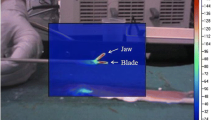Abstract
Objective
To characterize laparoscopic ultrasonic dissector surgical plume emission (laminar or turbulent) and investigate plume settlement time between curved and straight blades.
Materials and methods
A straight and a curved blade laparoscopic ultrasonic dissector were activated on tissue and in a liquid environment to evaluate plume emission. Plume emission was characterized as either laminar or turbulent and the plume settlement times were compared. Devices were then placed in liquid to observed consistency in the fluid disruption.
Results
Two types of plume emission were identified generating different directions of plume: laminar flow causes minimal visual obstruction by directing the aerosol downwards, while turbulent flow directs plume erratically across the cavity. Laminar plume dissipates immediately while turbulent plume reaches a second maximum obstruction approximately 0.3 s after activation and clears after 2 s. Turbulent plume was observed with the straight blade in 10 % of activations, and from the curved blade in 47 % of activations. The straight blade emitted less obstructive plume.
Conclusion
Turbulent flow is disruptive to laparoscopic visibility with greater field obstruction and requires longer settling than laminar plume. Ultrasonic dissectors with straight blades have more consistent oscillations and generate more laminar flow compared with curved blades. Surgeons may avoid laparoscope smearing from maximum plume generation depending on blade geometry.



Similar content being viewed by others
References
Kim FJ, Sehrt D, Pompeo A, Molina WR (2012) Comparison of surgical plume among laparoscopic ultrasonic dissectors using a real-time digital quantitative technology. Surg Endosc 26:3408–3412
Weld KJ, Dryer S, Ames C, Cho K, Hogan C, Lee M, Biswas P, Landman J (2007) Analysis of surgical smoke produced by various energy-based instruments and effect on laparoscopic visibility. Surg Endosc 3:347–351
Schneider A, Doundoulakis E, Can S, Fiolka A, Wilhelm D, Feussner H (2009) Evaluation of mist production and tissue dissection efficiency using different types of ultrasound shears. Surg Endosc 23:2822–2826
Van Det M, Meijerink W, Hoff C, Totte E, Pierie J (2009) Optimal ergonomics for laparoscopic surgery in minimally invasive surgery suites: a review and guidelines. Surg Endosc 23:1279–1285
Batchelor G (2000) Introduction to fluid mechanics. Cambridge University Press, Cambridge
Gossot D, Buess G, Cuschieri A, Leporte E, Lirici M, Marvik R, Meijer D, Melzer A, Schurr MO (1999) Ultrasonic dissection for endoscopic surgery. Surg Endosc 13:412–417
Cimino W, Bond L (1996) Physics of ultrasonic surgery using tissue fragmentation: part I. Ultrasound Med Biol 1:89–100
Uhrich ML, Underwood RA, Standeven JW, Soper NJ, Engsberg JR (2002) Assessment of fatigue, monitor placement, and surgical experience during simulated laparoscopic surgery. Surg Endosc 16:635–639
Acknowledgments
None.
Disclosures
Fernando J. Kim is a principal investigator for Olympus, Covidien, Healthtronics, Amgem, and Cubist. Wilson R. Molina has a fellowship grant with Boston Scientific. David Sehrt and Dr. Rodrigo da Silva have no conflicts of interest or financial ties to disclose.
Funding
This article was self-supported.
Author information
Authors and Affiliations
Corresponding author
Rights and permissions
About this article
Cite this article
Kim, F.J., Sehrt, D., Pompeo, A. et al. Laminar and turbulent surgical plume characteristics generated from curved- and straight-blade laparoscopic ultrasonic dissectors. Surg Endosc 28, 1674–1677 (2014). https://doi.org/10.1007/s00464-013-3369-6
Received:
Accepted:
Published:
Issue Date:
DOI: https://doi.org/10.1007/s00464-013-3369-6




